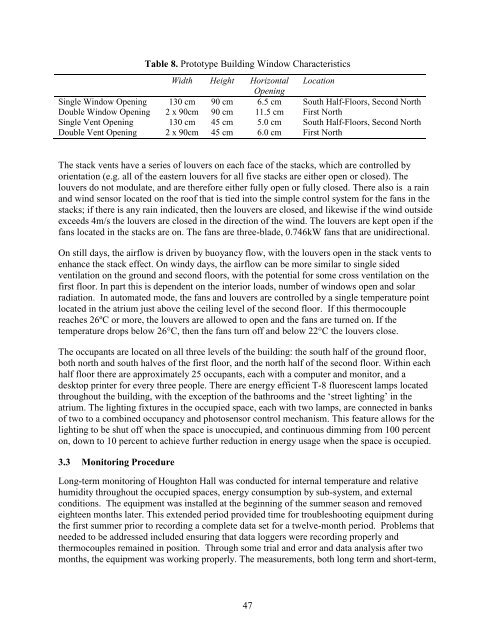Methodology for the Evaluation of Natural Ventilation in ... - Cham
Methodology for the Evaluation of Natural Ventilation in ... - Cham
Methodology for the Evaluation of Natural Ventilation in ... - Cham
You also want an ePaper? Increase the reach of your titles
YUMPU automatically turns print PDFs into web optimized ePapers that Google loves.
Table 8. Prototype Build<strong>in</strong>g W<strong>in</strong>dow CharacteristicsWidth Height Horizontal LocationOpen<strong>in</strong>gS<strong>in</strong>gle W<strong>in</strong>dow Open<strong>in</strong>g 130 cm 90 cm 6.5 cm South Half-Floors, Second NorthDouble W<strong>in</strong>dow Open<strong>in</strong>g 2 x 90cm 90 cm 11.5 cm First NorthS<strong>in</strong>gle Vent Open<strong>in</strong>g 130 cm 45 cm 5.0 cm South Half-Floors, Second NorthDouble Vent Open<strong>in</strong>g 2 x 90cm 45 cm 6.0 cm First NorthThe stack vents have a series <strong>of</strong> louvers on each face <strong>of</strong> <strong>the</strong> stacks, which are controlled byorientation (e.g. all <strong>of</strong> <strong>the</strong> eastern louvers <strong>for</strong> all five stacks are ei<strong>the</strong>r open or closed). Thelouvers do not modulate, and are <strong>the</strong>re<strong>for</strong>e ei<strong>the</strong>r fully open or fully closed. There also is a ra<strong>in</strong>and w<strong>in</strong>d sensor located on <strong>the</strong> ro<strong>of</strong> that is tied <strong>in</strong>to <strong>the</strong> simple control system <strong>for</strong> <strong>the</strong> fans <strong>in</strong> <strong>the</strong>stacks; if <strong>the</strong>re is any ra<strong>in</strong> <strong>in</strong>dicated, <strong>the</strong>n <strong>the</strong> louvers are closed, and likewise if <strong>the</strong> w<strong>in</strong>d outsideexceeds 4m/s <strong>the</strong> louvers are closed <strong>in</strong> <strong>the</strong> direction <strong>of</strong> <strong>the</strong> w<strong>in</strong>d. The louvers are kept open if <strong>the</strong>fans located <strong>in</strong> <strong>the</strong> stacks are on. The fans are three-blade, 0.746kW fans that are unidirectional.On still days, <strong>the</strong> airflow is driven by buoyancy flow, with <strong>the</strong> louvers open <strong>in</strong> <strong>the</strong> stack vents toenhance <strong>the</strong> stack effect. On w<strong>in</strong>dy days, <strong>the</strong> airflow can be more similar to s<strong>in</strong>gle sidedventilation on <strong>the</strong> ground and second floors, with <strong>the</strong> potential <strong>for</strong> some cross ventilation on <strong>the</strong>first floor. In part this is dependent on <strong>the</strong> <strong>in</strong>terior loads, number <strong>of</strong> w<strong>in</strong>dows open and solarradiation. In automated mode, <strong>the</strong> fans and louvers are controlled by a s<strong>in</strong>gle temperature po<strong>in</strong>tlocated <strong>in</strong> <strong>the</strong> atrium just above <strong>the</strong> ceil<strong>in</strong>g level <strong>of</strong> <strong>the</strong> second floor. If this <strong>the</strong>rmocouplereaches 26ºC or more, <strong>the</strong> louvers are allowed to open and <strong>the</strong> fans are turned on. If <strong>the</strong>temperature drops below 26°C, <strong>the</strong>n <strong>the</strong> fans turn <strong>of</strong>f and below 22°C <strong>the</strong> louvers close.The occupants are located on all three levels <strong>of</strong> <strong>the</strong> build<strong>in</strong>g: <strong>the</strong> south half <strong>of</strong> <strong>the</strong> ground floor,both north and south halves <strong>of</strong> <strong>the</strong> first floor, and <strong>the</strong> north half <strong>of</strong> <strong>the</strong> second floor. With<strong>in</strong> eachhalf floor <strong>the</strong>re are approximately 25 occupants, each with a computer and monitor, and adesktop pr<strong>in</strong>ter <strong>for</strong> every three people. There are energy efficient T-8 fluorescent lamps locatedthroughout <strong>the</strong> build<strong>in</strong>g, with <strong>the</strong> exception <strong>of</strong> <strong>the</strong> bathrooms and <strong>the</strong> ‗street light<strong>in</strong>g‘ <strong>in</strong> <strong>the</strong>atrium. The light<strong>in</strong>g fixtures <strong>in</strong> <strong>the</strong> occupied space, each with two lamps, are connected <strong>in</strong> banks<strong>of</strong> two to a comb<strong>in</strong>ed occupancy and photosensor control mechanism. This feature allows <strong>for</strong> <strong>the</strong>light<strong>in</strong>g to be shut <strong>of</strong>f when <strong>the</strong> space is unoccupied, and cont<strong>in</strong>uous dimm<strong>in</strong>g from 100 percenton, down to 10 percent to achieve fur<strong>the</strong>r reduction <strong>in</strong> energy usage when <strong>the</strong> space is occupied.3.3 Monitor<strong>in</strong>g ProcedureLong-term monitor<strong>in</strong>g <strong>of</strong> Houghton Hall was conducted <strong>for</strong> <strong>in</strong>ternal temperature and relativehumidity throughout <strong>the</strong> occupied spaces, energy consumption by sub-system, and externalconditions. The equipment was <strong>in</strong>stalled at <strong>the</strong> beg<strong>in</strong>n<strong>in</strong>g <strong>of</strong> <strong>the</strong> summer season and removedeighteen months later. This extended period provided time <strong>for</strong> troubleshoot<strong>in</strong>g equipment dur<strong>in</strong>g<strong>the</strong> first summer prior to record<strong>in</strong>g a complete data set <strong>for</strong> a twelve-month period. Problems thatneeded to be addressed <strong>in</strong>cluded ensur<strong>in</strong>g that data loggers were record<strong>in</strong>g properly and<strong>the</strong>rmocouples rema<strong>in</strong>ed <strong>in</strong> position. Through some trial and error and data analysis after twomonths, <strong>the</strong> equipment was work<strong>in</strong>g properly. The measurements, both long term and short-term,47
















